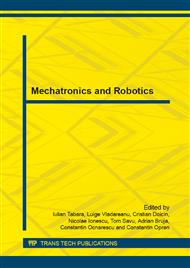p.169
p.175
p.183
p.189
p.195
p.201
p.205
p.213
p.219
Matlab Application for Hexapod Robot Locomotion over Obstacles
Abstract:
In this paper the authors present a software platform made using Matlab for studying hexapod robot stability in gravitational field and some basic locomotion simulations over obstacles. For the proposed design of the leg was calculated the kinematical model and a workspace analysis was made. The trajectory generator for the leg tip was implemented using piecewise cubic spline interpolation method. Next are presented the most common types of obstacles and the influence upon robot locomotion. The analysis of the robot static stability is made for different cases of loco-motion. The paper includes some simulation results related to the static gravitational stability de-pending on the support polygon, single leg control and locomotion over common types of obstacles.
Info:
Periodical:
Pages:
195-200
Citation:
Online since:
May 2015
Authors:
Keywords:
Price:
Сopyright:
© 2015 Trans Tech Publications Ltd. All Rights Reserved
Share:
Citation:


